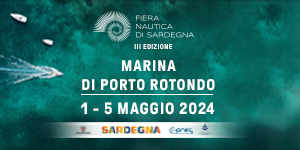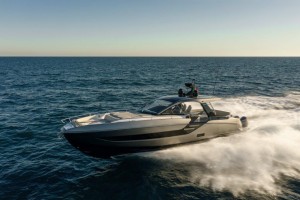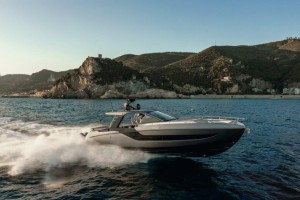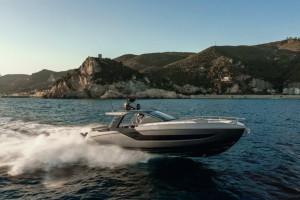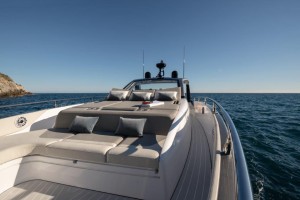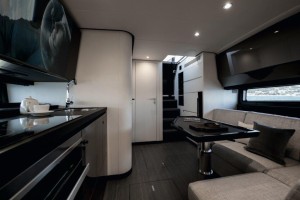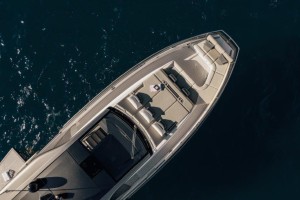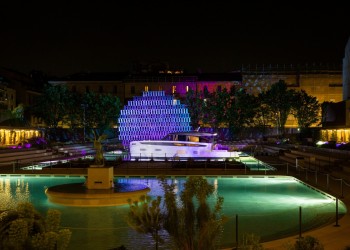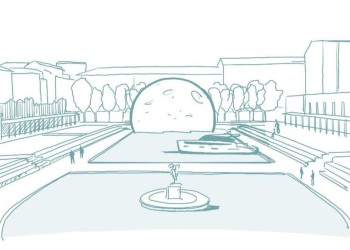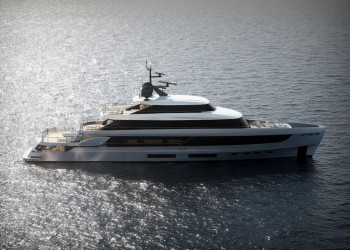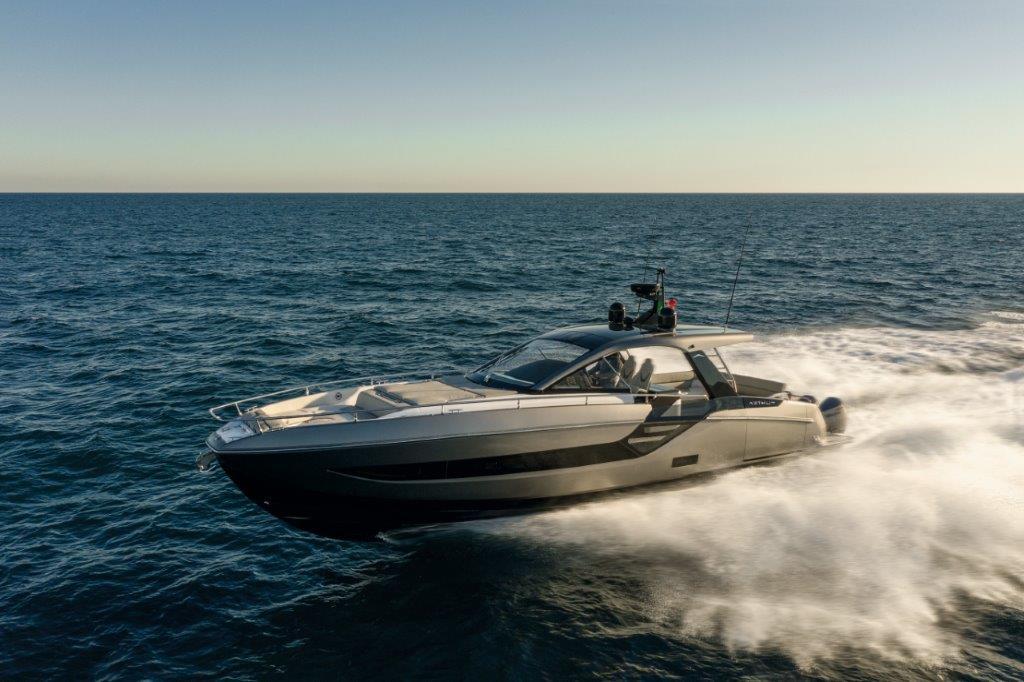
Azimut Yachts’ new Verve 47 outboard
Verve 47 by Azimut Yachts prémiere at Miami Yacht Show 2020
● Azimut Yachts’ new Verve 47 outboard is for owners who want to fly over the surface of the water at 50 knots, cutting the time it takes to move from one fantastic hotspot to another in the utmost comfort, for an adrenaline-pumping experience that creates an intimate bond with the sea.
● A product of collaboration between the Shipyard, Francesco Struglia and Michael Peters, Verve 47 is the ultimate boating machine and looks set to become the new benchmark for an all-Italian lifestyle.
● Francesco Struglia’s design springs from the desire to create a deep and extensive bond with the marine environment. The helm station has big side windows that extend the driver’s field of view and establish close contact with the outside world, introducing a design feature that has so far only been seen in a few celebrated super sports car projects.
● The hull by world famous naval architect Michael Peters delivers extraordinary handling, remarkable directional stability, significantly reduced drag and excellent performance, without affecting the dimensions and proportions of the hull.
● Four outboard engines rated 450 hp each, a latest generation joystick and a series of technical innovations complete this ambitious and original project.
Nicknamed “the ultimate boating machine”, Verve 47 is designed for an extremely modern owner attracted by the prospect of reaching his favourite hotspots quickly in an exciting, high-performance craft. Exceptional performance (a top speed of 50 knots), remarkable handling and the original design of the helm station make the new model from Azimut Yachts the perfect boat to go island hopping and enjoy a 360 degrees marine experience.
Remarkable livability, unprecedented on a boat this size, adds the worlwide appreciated Italian touch over to life on board the Verve 47. Combining top of the markets of centre console’s developments with the sophistication imprinted in Azimut Yachts’ DNA, this yacht is absolutely unique and looks set to establish a new standard in the world of outboards.
Lines and design
The bow design is based on offshore competition boats but retains the signature personality expressed by all Azimut Yachts, while the glazed surfaces in the hull reach up past and are integrated into the gunwale in order to establish a real bond with the sea.
“We took the typically American love of a sports-oriented lifestyle at sea as our starting point and then developed our own take on the concept based on Italian design criteria” said exterior and interior designer Francesco Struglia, who has always been attracted to the shapes created by dynamics and physics.
The young Italian designer’s work on the Verve 47 takes the intensely exciting ride typical of centre consoles to the next level: the helm station has been enhanced with a side window that creates a remarkable sense of continuity with the outside world. Indeed, the driver enjoys a special bond with the water, particularly at high speed, when the wake that is clearly visible on either side of the boat seems to become part of the yacht’s structure.
This authentic, exciting and unprecedented bonding between the driver and the outside world, a typical feature of Struglia’s work, is in a certain sense reminiscent of famous car designs like the Lamborghini Marzal designed by Marcello Gandini (1967), the Maserati Boomerang by Giorgetto Giugiaro (1971) or, more recently, the Vision GT line by Lamborghini, all featuring a driving experience that seems to connect the driver and the road through a play of forms and reflections.
The flow line defined by the windows sets the tone for the deck’s development in a circular play of contrasts and light. At high speed, the wake can clearly be seen forming on either side of the glazed surfaces and merging into the seascape.
The design of the windows also facilitates communication between the driver and the yacht’s interior, which is designed to form part of an ensemble with the exterior, in such a way as to create a product in which a sporty personality and ultimate comfort live together in perfect harmony.
Turning to the materials, the new-concept laminates chosen for the interiors offer the handfeel of wood in a very hi-tech setting, while the “shockwave” pattern of the synthetic teak aims to exploit the full potential of a choice that is both ecological and practical.
Layout
Azimut Yachts has worked to obtain the maximum from the interior and exterior spaces. The roomy cockpit, with its fully recessed high-low table and a swing-down side wall equipped for entering the water, can be used for different purposes at different times of day: a dining area, somewhere to relax and sunbathe or, alternatively, as a completely unencumbered, sea-facing ‘party’ space that is perfectly aligned with the design philosophy. The relaxation area in the bow has an asymmetrical layout that can accommodate additional comfortable seating and a big sun pad.
The refrigerators and the outdoor and indoor storage compartments are all generously sized to cater for longer stays on board.
The spacious and welcoming outdoor area in the stern has everything needed to relax and enjoy the open air life, including a multipurpose unit fitted with a wet bar, fridge, ice maker, barbecue, hob and sink. The setup is completed by a TV that can be raised and lowered.
The helm station features a plug and play layout and a glass cockpit dashboard with an extremely clean hi-tech design accentuated by scenic LED lighting. The helm seat can be adjusted electrically and is flanked on the right and left by two more seats. All three have an ergonomic design that tips its hat to the automotive industry.
The full-beam dinette-galley amidships is designed to offer even more relaxation, with an L-shaped sofa seating three, a table with a fixed stainless steel base and, on request, a wine cooler.
Two night cabins: the owner’s double cabin in the bow and a second cabin in the stern with twin beds. The bathroom has a separate shower stall.
The storage area in the stern can accommodate two seabobs and an inflatable paddle board, with easy-to-reach stowage space for the fenders next to the console.
Hull
The hull has a deep V and a central stern tunnel, based on the famous Stepped ‘V’ Ventilated Tunnel (SVVT) developed and patented by the outstandingly talented US designer Michael Peters.
The classic deep V with two steps and a central stern tunnel improves the boat’s longitudinal stability when turning at high speed.
Peters has been a prolific designer since the early 1970s and is regarded as the leading authority on fast hulls. Verve 47 not only boasts a hull designed by him, but is also the largest boat on the market with this type of hull.
Designed to reduce water resistance significantly and deliver excellent performance without affecting the size and proportions of the hull, it guarantees extraordinary directional stability even when turning.
High precision rudder response ensures that any obstacles in the boat’s path can be avoided, even at very high speeds.
The yacht is also extremely easy to handle and in particular to moor, not least because of the latest generation joystick.
Design technology
One major innovation is the first extensive application in a marine setting of virtual prototyping and immersive reality techniques, which were used to develop the dashboard, as well as for the visibility study and the ergonomic assessment of the wetbar and the interiors using the Oculus-type virtual headset. The introduction of these techniques has significantly reduced the effort needed for spatial and movement control, which previously required much more work.
Months of design work were dedicated to specific technical aspects, from storage analysis to the functions assigned to each space, with the aim of anticipating and satisfying all the needs of future owners.
Engines
Verve 47 has four Mercury Verado V8 four-stroke outboard engines rated 450 hp each, driving the boat to a top speed of 50 knots and a cruising speed of 37 knots.
DESIGNER BIOS
Francesco Struglia
After training as an industrial designer, he immediately became involved in the world of boat design while writing his thesis under the supervision of Giovanni Zuccon, who a week later invited him to his offices. It marked the start of a four-year period during which he developed an approach to design that combines freehand drawing with advanced three-dimensional mathematics. In 2011, he moved to the Netherlands to work with Frank Laupman and his highly-reputed Omega Architects firm. It was a key period of learning for him and instrumental in his ability to forge an alliance between the natural ability of the Dutch to turn physics into art (something he has wholeheartedly made his own) and the passion and creativity imprinted in the DNA of all Italian designers. On his return to Italy, he joined Azimut-Benetti group and became the company’s main point of liaison with the great boat designer Stefano Righini, who has been an important influence on him right from the outset. In 2017, he opened his own design studio.
While he has many sources of inspiration, one in particular is worthy of note: the beauty of forms shaped by dynamics and physics. He likes to represent the relationship between elements and think of an object as a set of shapes and events that interact as though they possessed their own temporal identity. As a result, the image of an undisturbed surface that evolves in response to a moving blade originates a design process that starts in the bow and extends sternwards, before literally exploding in glazed surfaces that bring those on board into eye-level contact with the water and spray from the wake.
In this way, the design of an object that is apparently composed of shapes and reflections becomes the interpretation of a sequence of events that run through the gamut of human moods.
Michael Peters
In the early 1970s, Micael Peters began designing high speed hulls for small planing boats developed specifically for the choppy waters off the coast of Southern California. He soon developed a passionate interest in offshore competition boats and began developing fast deep V hulls. In 1976, he designed and patented his first “stepped hull” and pioneered the adaptation of this particular type of hull. During his subsequent career designing competition boats, ‘his’ catamarans won 20 World Championships, 15 of them in consecutive years from 2001 to 2015. In a career spanning over 45 years, the hulls Michael has designed have won numerous speed records, including the first offshore boat to exceed 200 mph. Today, MPYD - Michael Peters Yacht Design is the world’s leading designer of high performance powerboats with stepped hulls.
VERVE 47 – TECHNICAL FEATURES
Lunghezza fuori tutto Length overall 14,50 m – 47’ 7’’
Lunghezza scafo Length hull 13,97 m – 45’ 10’’
Larghezza max Beam max 4,10 m – 13’ 5’’
Immersione, max (incl. skeg) Draft, max (incl. skeg) 1,20 m – 3’ 1”
Dislocamento a pieno carico Displacement full loaded approx 17,5 t
Motorizzazione/Trasmissione Engines/Trasmission 4 x Mercury Verado V8
450 hp
Velocità massima Maximum speed 50 nodi/kn
Velocità crociera Cruise speed 37 nodi/kn
Serbatoi carburante Fuel tank capacity 2.340 l (618,2 US Gls)
Serbatoi acqua dolce Water tank capacity 300 l (79,3 US Gls)
Cabine Cabins 2
Letti Berths 4
Materiale di costruzione Building material VTR
Costruttore Builder Azimut Yachts
Design esterni Exterior designer Francesco Struglia
Design interni Interior designer Francesco Struglia
Design carena Hull designer Michael Peters
Categoria / Certificazione Category / certification CE Categoria B





